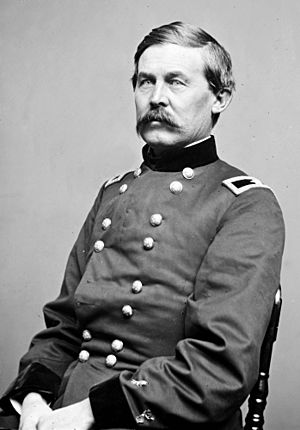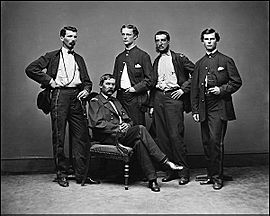John Buford facts for kids
Quick facts for kids
John Buford
|
|
|---|---|

Buford in 1863
|
|
| Birth name | John Buford Jr. |
| Born | March 4, 1826 Woodford County, Kentucky |
| Died | December 16, 1863 (aged 37) Washington, D.C. |
| Place of burial | |
| Allegiance |
|
| Service/ |
|
| Years of service | 1848–1863 |
| Rank | Major General |
| Commands held | Chief of Cavalry, Army of the Potomac |
| Battles/wars | |
| Relations | Napoleon Bonaparte Buford (half-brother) Abraham Buford (great-uncle) Abraham Buford II (cousin) |
John Buford Jr. (born March 4, 1826 – died December 16, 1863) was a brave officer in the United States Army. He was a cavalry officer, meaning he fought on horseback. Buford fought for the Union side during the American Civil War. He rose to the rank of brigadier general.
Buford is most famous for his actions on the first day of the Battle of Gettysburg on July 1, 1863. He quickly saw that Cemetery Hill and Cemetery Ridge were very important high areas. He placed his cavalry troops, called "vedettes" (like small guard posts), to the west and north. These troops bravely held off the enemy. This delay gave the main Union Army enough time to arrive and set up their defenses.
Buford was born in Kentucky, a state that was divided during the Civil War. He graduated from West Point in 1848. When the war began, he stayed loyal to the United States. He fought against the Confederate Army of Northern Virginia. His first big command was a cavalry brigade under Major General John Pope. He showed great courage at the Second Battle of Bull Run in August 1862, where he was wounded. He also fought at Antietam and during Stoneman's Raid.
Buford's cavalry division was key in the Gettysburg Campaign that summer. He arrived in Gettysburg, Pennsylvania, on June 30, before the Confederate troops. He quickly set up strong defensive positions. On the morning of July 1, Confederate troops attacked Buford's division. His men fought hard and held their ground just long enough for Union reinforcements to arrive. After a huge three-day battle, the Union troops won. Later, Buford helped the Army chase Robert E. Lee after Gettysburg. He also served well in the Bristoe Campaign that autumn. Sadly, his health began to fail, possibly from typhoid fever. Just before he died at age 37, President Abraham Lincoln personally promoted him to major general. This was to honor his amazing skill and leadership at Gettysburg.
Contents
Early Life and Military Training
John Buford Jr. was born in Woodford County, Kentucky. When he was eight, his family moved to Rock Island, Illinois. His father, John Buford Sr., was a well-known politician. The Buford family had a long history of military service. John Jr.'s grandfather, Simeon Buford, was a cavalry soldier in the American Revolutionary War. His great-uncle, Colonel Abraham Buford, also served in the military. John's half-brother, Napoleon Bonaparte Buford, became a major general for the Union. His cousin, Abraham Buford II, became a brigadier general for the Confederates.
After studying at Knox College, Buford was accepted into the United States Military Academy (West Point) in 1844. Many future famous generals were at West Point with him. These included George B. McClellan, Thomas J. Jackson, and George Pickett. He also studied with Henry Heth, whom he would later face at Gettysburg. Buford and Heth had actually fought together in the U.S. Army in 1855.
Buford graduated 16th in his class of 38 cadets. He joined the 1st U.S. Dragoons, a cavalry unit. He served in Texas and fought against the Sioux people. He also helped keep peace in Bleeding Kansas and served in the Utah War in 1858. He was stationed at Fort Crittenden, Utah, from 1859 to 1861. During this time, he studied military tactics.
Choosing a Side in the Civil War
By 1860, soldiers like Buford were talking about states leaving the Union. The news that Fort Sumter had been attacked in April 1861 meant the Civil War had truly begun. Like many officers, Buford had to choose between the North and the South.
Buford had reasons to join the Confederacy. He was from Kentucky, a state with slavery. His father owned slaves, and some of his wife's relatives fought for the South. However, Buford had been educated in the North. He had also spent many years in the U.S. Army. His military mentors were Southerners who chose to stay with the Union. He loved being a soldier, and his time on the frontier had weakened his ties to the South.
John Gibbon, another officer from the South, remembered a night when Buford decided to stay with the Union:
One night after the arrival of the mail we were in his (Buford's) room, when Buford said in his slow and deliberate way "I got a letter from the Governor of Kentucky. He sent me word to come to Kentucky at once and I shall have anything I want." With a good deal of anxiety, I (Gibbon) asked "What did you answer, John?" And my relief was great when he replied "I sent him word I was a Captain in the United States Army and I intended to remain one!"
Buford's Role in the Civil War
In November 1861, Buford became an Assistant Inspector General. In July 1862, he was promoted to brigadier general. He served in the defense of Washington. In 1862, he led the II Corps Cavalry Brigade under Major General John Pope. This unit fought very well at the Second Battle of Bull Run. Buford personally led a charge during the battle. He was wounded in the knee, but it was not a serious injury.
He quickly returned to duty. He served as chief of cavalry for Major Generals George B. McClellan and Ambrose E. Burnside. This was mostly a desk job, and Buford wanted to be in the field leading troops. He fought in the battles of South Mountain and Antietam. In 1863, under Major General Joseph Hooker, Buford finally got to lead a cavalry division.
Buford led his new division at the Battle of Brandy Station, which was a huge cavalry battle. He also fought at the Battle of Upperville.
During the Gettysburg Campaign, Buford was promoted to command the 1st Division. He is famous for choosing the battlefield at Gettysburg. On June 30, Buford's troops rode into the town. He quickly realized that a much larger Confederate force was coming. He immediately set up defenses. He knew how important it was to hold the high ground south of Gettysburg. His smart placement of troops and the bravery of his men allowed the I Corps to arrive and hold these key positions. This was crucial to the Union victory in the three-day battle.
After Gettysburg, Buford's troops were sent to resupply. This left the Union's left side open. In the Retreat from Gettysburg, Buford chased the Confederates. He also helped Major General George Meade move his troops back during the Bristoe Campaign in October 1863.
Many praised Buford's leadership:
The hero at Oak Ridge was John Buford ... he not only showed the rarest tenacity, but his personal capacity made his cavalry accomplish marvels, and rival infantry in their steadfastness ... Glorious John Buford!
Buford despised the false flourish and noisy parade of the charlatans of his service. He avoided too, perhaps, the proper praise due his glorious actions, his bravery and dash, without ostentation or pride, his coolness and able management and above all, the care of his men endeared him to all.
Death and Lasting Legacy
By mid-December 1863, it was clear that Buford was very sick, possibly with typhoid fever. He went to stay at the Washington home of his good friend, General George Stoneman. On December 16, Stoneman suggested that Buford be promoted to major general. President Abraham Lincoln agreed, writing: "I am informed that General Buford will not survive the day. It suggests itself to me that he will be made Major General for distinguished and meritorious service at the Battle of Gettysburg."
When told of the promotion, Buford asked, "Does he mean it?" When he was told it was real, he simply replied, "It is too late, now I wish I could live."
In his final hours, Buford was cared for by his aide, Captain Myles Keogh, and his servant, Edward. His wife, Pattie, was traveling to be with him but did not arrive in time. Near the end, he became confused. But then, in a clear moment, he called for Edward and apologized: "Edward, I hear that I have been scolding you. I did not know what I was doing. You have been a faithful servant, Edward."
John Buford died at 2 p.m. on December 16, 1863. Myles Keogh held him in his arms. His last reported words were, "Put guards on all the roads, and don't let the men run to the rear."
On December 20, a memorial service was held in Washington, D.C. President Lincoln was among those who mourned. Buford's wife was too ill to attend. Generals Hancock and Doubleday were among the pallbearers. General Stoneman led the procession, which included "Grey Eagle," Buford's old white horse from Gettysburg.
After the service, Captains Keogh and Wadsworth took Buford's body to West Point. He was buried next to Lieutenant Alonzo Cushing, another hero from Gettysburg. Cushing had died defending the "high ground" that Buford had chosen. In 1865, a 25-foot tall monument was built over Buford's grave. It was paid for by members of his old division. His staff officers wrote a statement showing how much they respected him:
... we, the staff officers of the late Major General John Buford, fully appreciating his merits as a gentleman, soldier, commander, and patriot, conceive his death to be an irreparable loss to the cavalry arm of the service. That we have been deprived of a friend and leader whose sole ambition was our success, and whose chief pleasure was in administering to the welfare, safety and happiness of the officers and men of his command.
... That to his unwearied exertions in the many responsible positions which he has occupied, the service at large is indebted for much of its efficiency, and in his death the cavalry has lost firm friend and most ardent advocate. That we are called to mourn the loss of one who was ever to us as the kindest and tenderest father, and that our fondest desire and wish will ever be to perpetuate his memory and emulate his greatness."
In 1866, a military fort in what is now North Dakota was named Fort Buford in his honor. The town of Buford, Wyoming, was also renamed for him. In 1895, a bronze statue of Buford was placed on the Gettysburg Battlefield. It was designed by artist James E. Kelly. The M8 Armored Gun System, a light tank, was sometimes called the "Buford" in his honor.
In Popular Culture
- Buford was played by Sam Elliott in the 1993 film Gettysburg. This movie was based on Michael Shaara's novel The Killer Angels.
- Buford is a character in the novel Gettysburg: A Novel of the Civil War. This book was written by Newt Gingrich and William Forstchen.


